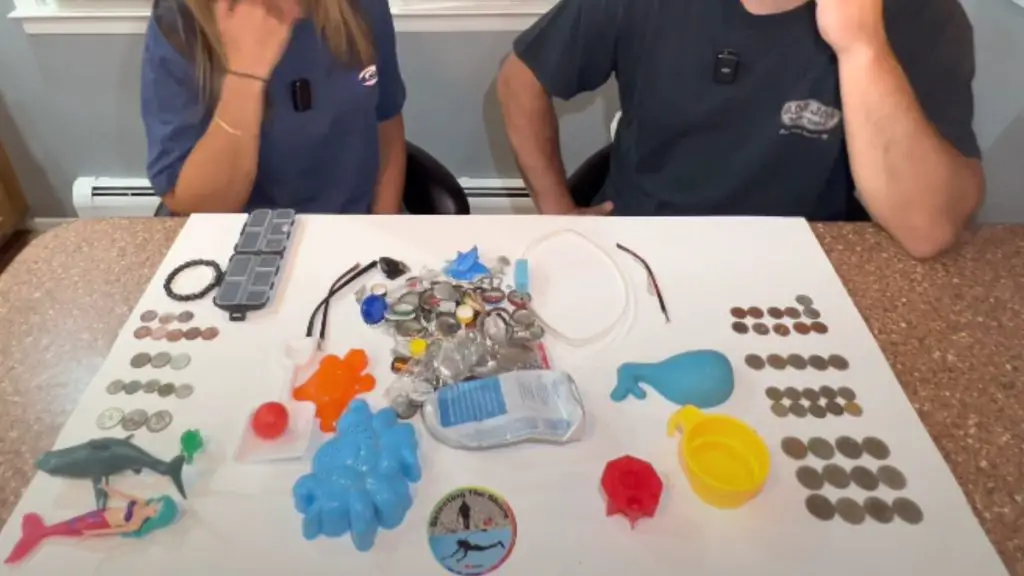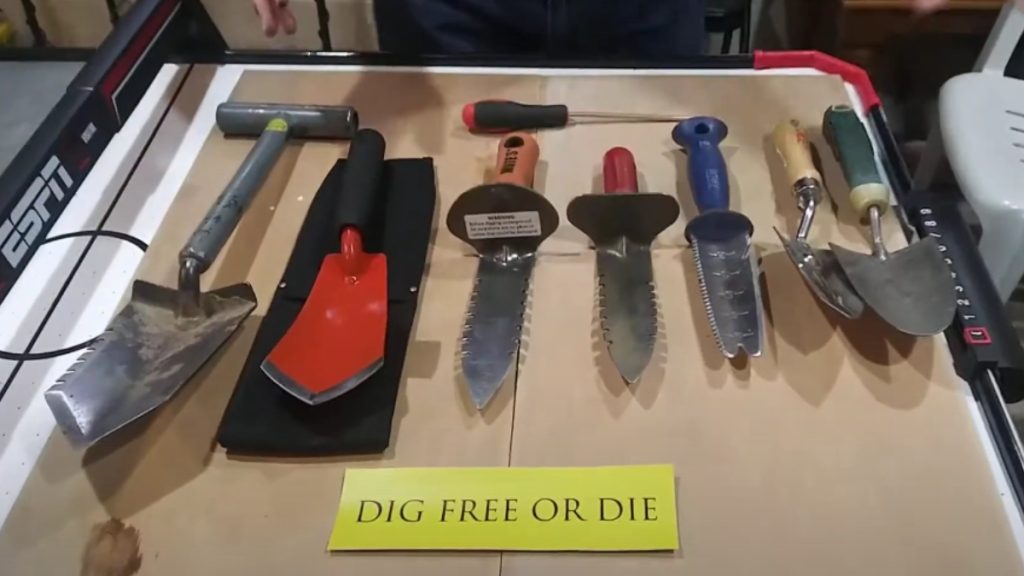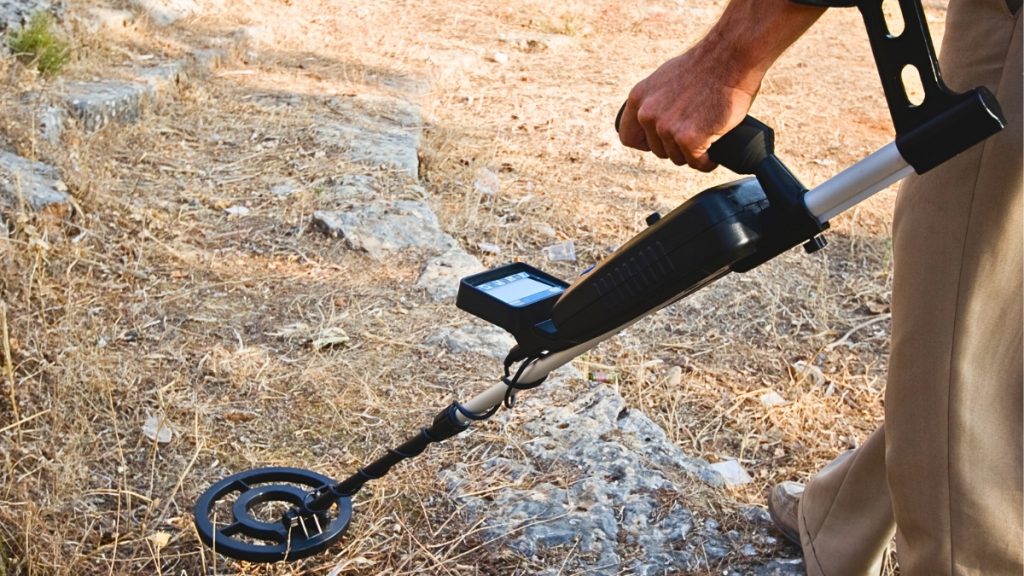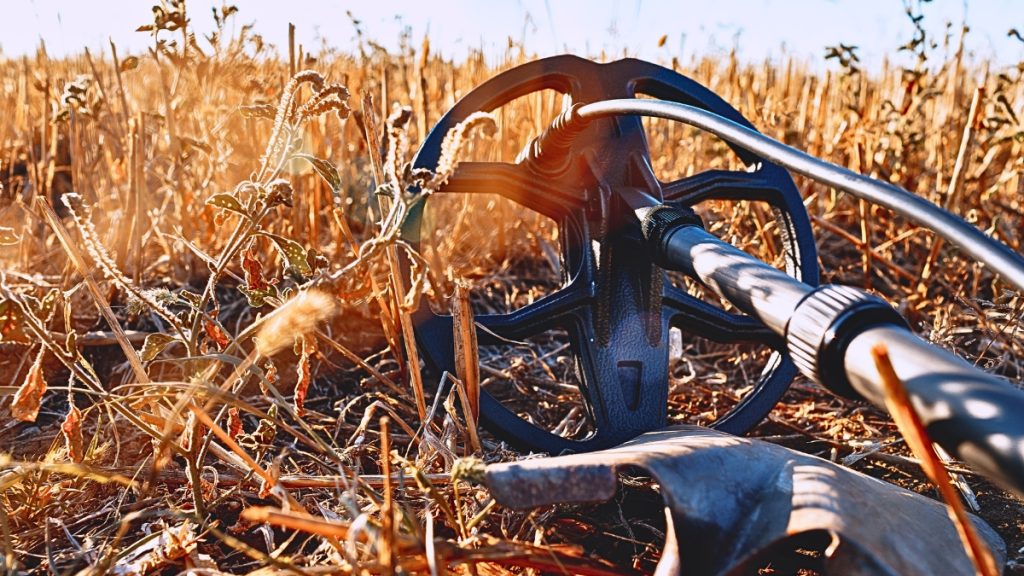Metal detecting is a fascinating hobby that combines adventure, history, and the thrill of discovery.
Whether you’re exploring your local beach, seeking long-lost treasures in the woods, or just scanning your backyard, this guide is here to help you begin.
In this guide I’ll walk you through the basics of metal detecting, from choosing the right detector to understanding the signals.
Let’s dive in!

What is Metal Detection?
Metal detection is a technique used to find metal objects hidden within other materials. This is especially useful for locating metal in the ground, inside food, or even within construction materials.
Metal detectors are devices that emit a magnetic field. When this field comes into contact with metal, the metal interferes with the field, and the detector signals this disturbance, usually through sound, lights, or a combination of both.
This makes metal detection invaluable in various fields, including security, archaeology, and the food industry, to ensure safety and integrity.
History of metal detectors
Here’s a simple overview of metal detectors evolution:
1. Military Beginnings
Metal detectors were first used by the military. During World War I, these devices helped soldiers find unexploded bombs and other dangerous metal objects on battlefields.
This early use saved many lives and showed the potential of metal detection technology.
2. From Battlefield to Backyard
After the wars, people started using metal detectors for non-military purposes.
Treasure hunters and historians began using them to find lost coins, jewelry, and historical artifacts buried underground.
This hobby became very popular, and many people started exploring their backyards and local areas for hidden treasures.
3. Metal Detection’s Modern Role
Today, metal detectors are used in various fields, not just for finding treasure.
They play a crucial role in archaeology for discovering ancient artifacts without damaging the surrounding area.
They’re also used in construction to locate buried pipes and wires before digging.
4. Guardians of Safety
Metal detectors are important for safety and security. Airports, schools, and public buildings use them to check for weapons and prevent violence.
This use of metal detectors helps keep public places safe for everyone.
5. Time Capsules Unearthed
Archaeologists and historians use metal detectors to find time capsules from the past.
These discoveries can provide valuable insights into ancient civilizations and historical events, helping us understand more about our history.
6. Metal in the Machine
In the manufacturing industry, metal detectors ensure that food and other products are free from metal contamination.
This is crucial for consumer safety, as ingesting metal pieces can be harmful.
What’re Essential Accessories for Metal Detection?

1. Headphones
Headphones are crucial for metal detecting because they allow you to hear the beep signals clearly, even in noisy or windy environments.
This makes it easier to detect small or deeply buried objects.
You should choose headphones that are comfortable to wear for long hours and ensure they’re compatible with your metal detector’s audio output.
2. Digging Tools
These include small shovels, trowels, or specialized digging tools designed for metal detecting.
The purpose of these tools is to help you carefully extract your finds from the ground without causing damage to them or to the surrounding area.
So, you should choose tools that are durable and suited to the terrain you’ll be exploring.
For example, a lightweight trowel might be perfect for sandy areas, while a more robust shovel could be necessary for harder soils.
3. Pinpointer
A “Pinpointer” is a small, handheld tool that helps you find exactly where a metal object is buried.
When you’re metal detecting and your larger detector tells you there’s something under the ground, you use the pinpointer to pinpoint the exact location.
This saves you time and effort because you dig smaller holes and find your treasures faster.
4. Finds Pouch or Bag
A pouch or bag is a must-have accessory for anyone using a metal detector. When you find small items like coins, jewelry, or historical artifacts, you need a safe place to store them.
A sturdy pouch or bag keeps your finds secure and organized, so they don’t get lost or damaged while you continue your search.
5. Cleaning Kit
A Cleaning Kit is a must-have for anyone who enjoys metal detecting. After finding a metal object, it’s often covered in dirt or tarnished.
Having a cleaning kit allows you to gently clean and preserve your finds without damaging them.
Your kit should include soft brushes, microfiber cloths, and a mild cleaning solution suitable for various metals.
6. Coil Cover
A “Coil Cover” is a protective shield that fits over the metal detector’s search coil; the round, flat part that you sweep over the ground.
Since the coil is the part of the detector that actually senses the metal, it’s really important to keep it safe from scratches, dents, or any damage.
Using a coil cover helps your metal detector work better and last longer, making it a smart addition to your metal detecting gear.
7. Protective Gear
For starters, a good pair of gloves can protect your hands from sharp objects or rough terrain.
Then there’s footwear; sturdy shoes or boots are a must to keep your feet safe and comfortable while you’re walking around.
Also, if you plan to spend a lot of time in the sun, don’t forget a hat and sunglasses to shield yourself from harmful UV rays.
And lastly, considering the unpredictable weather, a waterproof jacket could be really helpful.
8. GPS Device or Smartphone with GPS App
When you’re exploring new areas looking for treasures, it’s easy to lose track of your path. That’s where a GPS device or a smartphone equipped with a GPS app comes in handy.
It helps you to know exactly where you are and how to get back to your starting point.
Plus, you can save the locations where you find something interesting, making it easier to return for further exploration or to share with fellow enthusiasts.
9. First Aid Kit
A First Aid Kit is crucial when you’re out metal detecting. It’s easy to get minor cuts or scrapes, especially if you’re digging in the ground or walking through rough terrain.
Your kit should have band-aids, antiseptic wipes, and some basic medications for pain or allergies.
Keeping this kit with you means you can handle small injuries right away and keep enjoying your treasure hunt without major interruptions.
10. Insect Repellent and Sunscreen
These items protect you from bug bites and sunburn. Bugs can be annoying and some carry diseases, so repellent keeps them away.
Sunscreen helps prevent skin damage from the sun’s rays. Both are essential for staying comfortable and safe while you search for treasures.
11. Reference Books and Maps
Reference books and maps can guide you to places where you’re more likely to find valuable items.
Reference books provide historical information and tips on identifying found objects, helping to increase your knowledge about different types of metals and artifacts.
Maps, especially old ones, can point you to locations that used to be populated or used for specific purposes, such as old homesteads, battlegrounds, or fairgrounds.
What Is a Metal Detector?

A metal detector is a tool that helps you find metal objects hidden under the ground. People use it as a hobby to look for treasures like old coins, jewelry, or historical artifacts.
When you move the metal detector over the ground, it makes a special sound if there’s metal below.
Types of Metal Detectors
1. Ground-based Metal Detectors

Ground-based metal detectors are a popular tool for treasure hunters, archaeologists, and anyone interested in discovering hidden metal objects beneath the surface of the earth.
These devices work by sending out electromagnetic waves into the ground.
When these waves encounter metal, the metal objects disrupt the pattern of the waves, and this change is detected by the metal detector.
The device then signals the user, usually through sounds, visual indicators, or vibrations, that metal is present.
Ground-based metal detectors can find a wide range of metal objects including coins, jewelry, relics, and even larger items like buried caches or unexploded munitions.
They vary in their depth of detection and sensitivity to different types of metals, which can be adjusted based on the specific needs of the user.
2. Handheld Metal Detectors
Handheld metal detectors are compact devices designed for closer inspection of individuals or specific items.
These portable units are used by security personnel at airports, concerts, and public events to ensure safety by detecting harmful metallic objects like knives or guns.
They are easy to use, with a simple operation that usually involves waving the device over or around a person or an item.
Handheld models emit a sound or light signal when they find metal, making it straightforward to identify when something needs a closer look.
3. Underwater Metal Detectors
Underwater metal detectors are special devices designed for people who love to search for treasures under the water.
They work just like regular metal detectors but are waterproof, so you can use them in rivers, lakes, or even the ocean.
These detectors can help you find all kinds of metal objects hidden beneath the water’s surface, from old coins and jewelry to historical artifacts.
Some are made to be used in shallow waters, while others can go deeper, allowing divers to explore the underwater world and its hidden treasures.
How to Choose the Right Type of Metal Detector?
First, you should consider what you’re hoping to find, such as coins, relics, or gold, as different detectors specialize in different types of targets.
For example, if you’re interested in gold prospecting, a gold-specific detector with a high frequency would be ideal.
If you’re searching on beaches or near water, look for a waterproof detector.
You should also consider the detector’s sensitivity and discrimination features to differentiate between valuable items and trash.
Lastly, factor in your budget and look for a detector that offers the features you need without overspending.
Always remember, a more expensive detector doesn’t always mean better for beginners; it’s about finding the right tool for your adventure.
Best Places for Metal Detection
You can go to metal detection hunt at these places:
| Place’s Name | Short Detail |
| Your Own Front and Back Yard | Potential treasures in older homes or from previous residents. |
| School Yards or Grounds | Lost lunch money, rings, and relics from past students. |
| Sporting Fields | Items lost by spectators around the fields and sidelines. |
| Around Bus Stops | Common spot for losing change while waiting. |
| Old Drive-In Theaters | High chance of finding coins and jewelry, especially near snack bars. |
| City Parks | Lost coins and jewelry in playgrounds, paths, and shaded areas. |
| Hunting Camps and Lodges | Profitable outside hunting season; permission required. |
| Beaches | “Towel line” areas are rich in lost jewelry. |
| Renaissance Fairs and Fair Grounds | Jewelry and items lost around stands and dressing areas. |
| College Campuses | Various treasures in student congregation areas. |
| Traveling Carnivals and Fairs | Focus on former food booth locations and rides. |
| Roadside Stands | Motorists often drop coins when purchasing. |
| CampGrounds | Wide range of lost items in both state-owned and privately owned campgrounds. |
| Ski Resorts | Jewelry lost around ski lifts due to cold-induced finger shrinkage. |
| Scout Camps | Potential for both modern and historical items in long-standing camps. |
| Churches | Old churches may hide treasures, excluding cemeteries. |
| Ghost Towns | Abandoned towns are great for finding old coins, jewelry, and relics with permission. |
| Bars and Taverns | Potential for finding coins, jewelry, and tavern-specific tokens. |
| Rest Stops | Rural rest stops on public land can yield lost items. |
| Old Barns | Possible buried savings and valuable old tools near barns. |
Is Metal Detection Legal?
The legality of metal detecting varies significantly depending on where you are. In the United States, for example, it’s generally allowed on public lands, but you may need a permit for certain areas, like state parks or historic sites.
So, you should always check the rules for the specific location where you plan to search.
In many other countries, the laws can be stricter, and you might need explicit permission from landowners or government authorities before you start.
Moreover, if you find anything that could be considered treasure or of historical significance, there are usually laws requiring you to report your find.
You should also do your research and understand the regulations in your area to ensure your metal detecting adventure is legal and respectful.
Techniques for pinpointing and retrieving targets
Here is the step-by-step guide on pinpointing & retrieving targets:
Step 1 – Sweep Slowly
Firstly move your metal detector slowly over the ground. Rushing can cause you to miss targets.
Step 2 – Listen Carefully
You should pay attention to the sounds your detector makes; different tones can indicate different types of metals.
Step 3 – Use Pinpoint Mode
Many detectors have a ‘pinpoint’ function to help locate the target more accurately once it’s detected.
Step 4 – Dig Carefully
Once you’ve located a target, use a small shovel or trowel to dig around the area. Be gentle to avoid damaging any potential finds.
Step 5 – Use a Handheld Pinpointer
A handheld pinpointer can help locate the exact position of the find in the hole or soil you’ve dug up.
Step 6 – Scan Again
After retrieving the item, scan the hole again. Sometimes there are multiple items in the same spot.
Step 7 – Fill the Hole
Lastly, fill back any holes you dig. It’s important to respect the environment and leave the site as you found it.
Metal Detection Clubs
Metal Detection Clubs are groups of people who enjoy using metal detectors to find metal objects buried underground.
These clubs organize events, share tips and tricks, and sometimes compete to see who can find the most interesting items.
Joining a metal detection club is a great way to meet people with similar interests, learn more about metal detecting, and explore new places.
Some of the best clubs offer training sessions for beginners, have loaner equipment for those just starting out, and organize outings to historical sites.
Maintenance and Care of Your Metal Detector
To take care of your metal detector, follow these simple steps:
After using your metal detector, gently clean it using a soft cloth. Pay attention to remove dirt or sand from the coil and the control box.
If your metal detector is not waterproof, ensure to keep it away from water. If it’s waterproof, still be cautious and dry it properly after use.
When not in use, store your metal detector in a cool, dry place. It’s best to keep it inside a bag or a case to protect it from dust and moisture.
Be gentle with your metal detector. Avoid dropping it or hitting it against hard surfaces.
Regularly check and replace the batteries to avoid leaks that can damage the device.
Always refer to your metal detector’s manual for specific care instructions and follow them closely.
Final Thoughts
Metal detecting is a fascinating hobby that not only gets you outside and moving but also connects you with history in a unique way.
Whether you’re searching for ancient coins, historic relics, or just enjoying the thrill of discovery, metal detecting offers endless adventures.
It’s a hobby that suits all ages and can be enjoyed solo or with friends and family. You never know, you might just find something truly valuable or historically significant.
- Metal Detection in Newcastle (Ultimate Guide for 2024)
- Metal Detecting In South Australia (Ultimate Guide)
- Metal Detection In Georgia (Ultimate Guide for 2024)
- Metal Detecting In New Hampshire (Ultimate Guide in 2024)
- Metal Detecting In New York (Ultimate Guide)
- Metal Detecting In New Jersey (Ultimate Guide In 2024)
- Metal Detecting In Louisiana (Ultimate Guide in 2024)
- Metal Detecting In West Virginia (Ultimate Guide in 2024)
- Metal Detecting In Virginia (Ultimate Guide in 2024)
- Metal Detecting In Kentucky (Ultimate Guide in 2024)
- Metal Detecting In Tennessee (Ultimate Guide in 2024)
- Metal Detecting In North Carolina (Ultimate Guide in 2024)
- Metal Detecting In South Carolina (Ultimate Guide in 2024)
- Metal Detecting In Alabama (Ultimate Guide in 2024)
- Metal Detecting In Mississippi (Ultimate Guide in 2024)
- Metal Detecting In Iowa (Ultimate Guide in 2024)
- Metal Detecting in Alaska (Ultimate Guide in 2024)
- Metal Detecting In Ontario (Ultimate Guide in 2024)
- Metal Detecting in Liverpool (Ultimate Guide in 2024)
- Metal Detecting in Queensland (Complete Guide in 2024)
- Metal Detecting in Tasmania (Ultimate Guide in 2024)
- Metal Detecting In Western Australia (Complete Guide)
